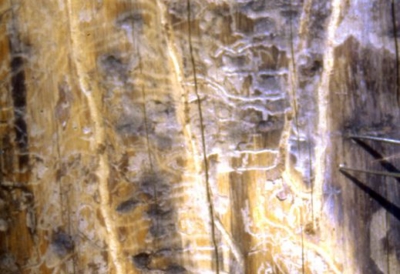The roundheaded pine beetle also referred to as Dendroctonus adjunctus, is a bark beetle which destroys pine trees. The pest should not be mistaken for the roundheaded borer which is commonly
A mixture of resin and boring dust could be found at the surface of their entrance in the first trees infested by the roundheaded pine beetles. The boring dust can be of any color; from brownish red to off white. Most times, pitch tubes are found on the trunk of the tree when the resins become solid. Trees with low infestation usually have larger pitch tubes than those with major infestation. The pitch tubes and boring dusts are usually noticeable during the period of attack- which is usually between late September and the beginning of November. Gradual discoloration is often noticed on leaves attacked by the roundheaded pine beetle; this change in color may begin as early as May of the next year after the infestation. The leaves would have turned straw brown before the end of July. By December of the next year after attack, most of the trees must have shredded their needles. However, some trees may still remain green and fresh for additional 12 to 16 months even after the presence of pitch tubes and boring dust on the bark.
Young adult beetles have colors which range from shiny dark brown to black, about 3mm wide and 6 mm long. The females are lightly bigger than males.
Their eggs are oblong shaped and pearly white color not more than 1.5mm in width and length. Larvae are legless, grub-like, and more of translucent, even though the abdomen’s content may have reddish brown hue. The larvae vary in size which ranges from the size of the egg to the size of an adult. The pupae are usually white and they have similar features with the adult such as wings cover, legs and antennae.
Comments are closed.